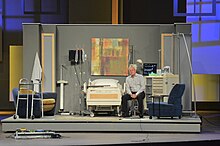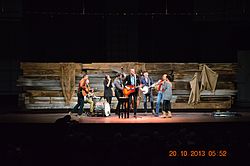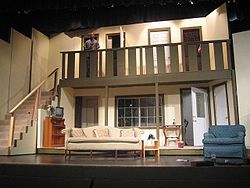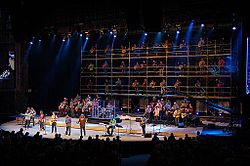
The following outline is provided as an overview of and topical guide to theatre:

A proscenium is the metaphorical vertical plane of space in a theatre, usually surrounded on the top and sides by a physical proscenium arch and on the bottom by the stage floor itself, which serves as the frame into which the audience observes from a more or less unified angle the events taking place upon the stage during a theatrical performance. The concept of the fourth wall of the theatre stage space that faces the audience is essentially the same.

Stagecraft is a technical aspect of theatrical, film, and video production. It includes constructing and rigging scenery; hanging and focusing of lighting; design and procurement of costumes; make-up; stage management; audio engineering; and procurement of props. Stagecraft is distinct from the wider umbrella term of scenography. Considered a technical rather than an artistic field, it is primarily the practical implementation of a scenic designer's artistic vision.
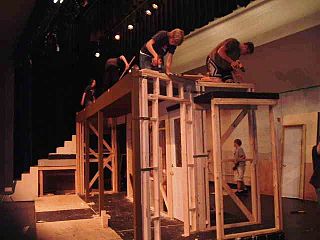
Set construction is the process undertaken by a construction manager to build full-scale scenery, as specified by a production designer or art director working in collaboration with the director of a production to create a set for a theatrical, film, or television production. The set designer produces a scale model, scale drawings, paint elevations, and research about props, textures, and so on. Scale drawings typically include a groundplan, elevation, and section of the complete set, as well as more detailed drawings of individual scenic elements which, in theatrical productions, may be static, flown, or built onto scenery wagons. Models and paint elevations are frequently hand-produced, though in recent years, many Production Designers and most commercial theatres have begun producing scale drawings with the aid of computer drafting programs such as AutoCAD or Vectorworks.

Scenic design is the creation of scenery for theatrical productions like plays and musicals. It may also be applied to film and television contexts, where it is referred to as production design. Scenic designers create sets and scenery to support the overall artistic goals of the production. Scenography includes theatrical set design as well as light and sound.

The Teatro Olimpico is a theatre in Vicenza, northern Italy, constructed in 1580–1585. It was the final design by the Italian Renaissance architect Andrea Palladio and was not completed until after his death. The trompe-l'œil onstage scenery, designed by Vincenzo Scamozzi to give the appearance of long streets receding to a distant horizon, was installed in 1585 for the first performance held in the theatre, and is the oldest surviving stage set still in existence. The full Roman-style scaenae frons back screen across the stage is made from wood and stucco imitating marble. It was the home of the Accademia Olimpica, which was founded there in 1555.
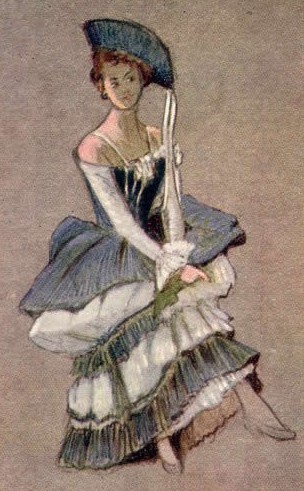
Costume design is the creation of clothing for the overall appearance of a character or performer. Costume may refer to the style of dress particular to a nation, a class, or a period. In many cases, it may contribute to the fullness of the artistic, visual world which is unique to a particular theatrical or cinematic production. The most basic designs are produced to denote status, provide protection or modesty, or provide visual interest to a character. Costumes may be for a theater, cinema, musical performance, cosplay, parties, or other events. Costume design should not be confused with costume coordination which merely involves altering existing clothing, although both create stage clothes.

Theater in the United States is part of the old European theatrical tradition and has been heavily influenced by the British theater. The central hub of the American theater scene is Manhattan, with its divisions of Broadway, Off-Broadway, and Off-Off-Broadway. Many movie and television stars have gotten their big break working in New York productions. Outside New York, many cities have professional regional or resident theater companies that produce their own seasons, with some works being produced regionally with hopes of eventually moving to New York. U.S. theater also has an active community theater culture, which relies mainly on local volunteers who may not be actively pursuing a theatrical career.
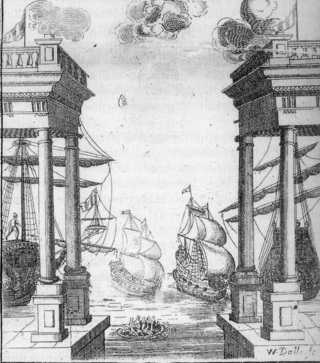
The Restoration spectacular was a type of theatre production of the late 17th-century Restoration period, defined by the amount of money, time, sets, and performers it required to be produced. Productions attracted audiences with elaborate action, acrobatics, dance, costume, scenery, illusionistic painting, trapdoors, and fireworks. Although they were popular with contemporary audiences, spectaculars have earned a reputation from theatre historians as vulgar in contrast to the witty Restoration drama.
A revolving stage is a mechanically controlled platform within a theatre that can be rotated in order to speed up the changing of a scene within a show. A fully revolving set was an innovation constructed by the hydraulics engineer Tommaso Francini for an elaborately produced pageant, Le ballet de la délivrance de Renaud, which was presented for Marie de Medici in January 1617 at the Palais du Louvre and noted with admiration by contemporaries. Such a stage is also commonly referred to as a turntable.

Baldassarre Lanci (1510–1571) was an Italian architect, inventor, theatrical set designer, and master of perspective of the Renaissance period. Born in Urbino, he spent most of his working life in Tuscany.

Nineteenth-century theatre describes a wide range of movements in the theatrical culture of Europe and the United States in the 19th century. In the West, they include Romanticism, melodrama, the well-made plays of Scribe and Sardou, the farces of Feydeau, the problem plays of Naturalism and Realism, Wagner's operatic Gesamtkunstwerk, Gilbert and Sullivan's plays and operas, Wilde's drawing-room comedies, Symbolism, and proto-Expressionism in the late works of August Strindberg and Henrik Ibsen.
A theatrical technician, also known as a theatrical tech, theatre technician, or theatre tech is a person who operates technical equipment and systems in the performing arts and entertainment industry. In contrast to performers, this broad category contains all "unseen" theatrical personnel who practice stagecraft and are responsible for the logistic and production-related aspects of a performance including designers, operators, and supervisors.
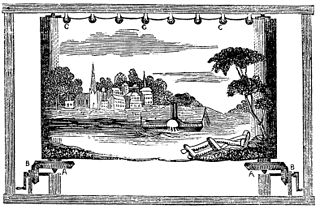
The moving panorama was an innovation on panoramic painting in the mid-nineteenth century. It was among the most popular forms of entertainment in the world, with hundreds of panoramas constantly on tour in the United Kingdom, the United States, and many European countries. Moving panoramas were often seen in melodramatic plays. It became a new visual element to theatre and helped incorporate a more realistic quality. Not only was it a special effect on stage, but it also served as an ancestor and platform to early cinema.
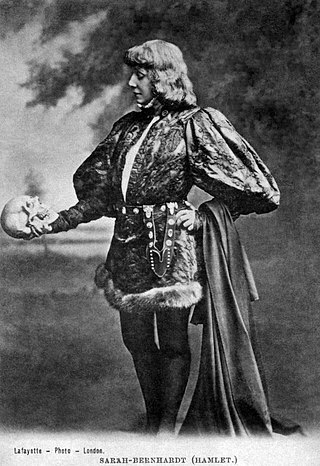
Theatre or theater is a collaborative form of performing art that uses live performers, usually actors or actresses, to present the experience of a real or imagined event before a live audience in a specific place, often a stage. The performers may communicate this experience to the audience through combinations of gesture, speech, song, music, and dance. It is the oldest form of drama, though live theatre has now been joined by modern recorded forms. Elements of art, such as painted scenery and stagecraft such as lighting are used to enhance the physicality, presence and immediacy of the experience. Places, normally buildings, where performances regularly take place are also called "theatres", as derived from the Ancient Greek θέατρον, itself from θεάομαι.
The following outline is provided as an overview of and topical guide to stagecraft:

Henry Hawes Craven Green was an English theatre scene-painter. He collaborated with Henry Irving, Richard D'Oyly Carte and Herbert Beerbohm Tree, producing stage sets of unprecedented realism. Craven's career lasted from 1853 to 1905, spanning the end of the era of gas lighting in theatres and the beginning of electrical lighting; he developed new techniques to co-ordinate the appearance of theatre settings during the transition from gas to electricity. He was regarded as the finest scene-painter of his day and was the last major scenic designer in the ultra-realistic tradition.
Theatre in the nineteenth century was noted for its changing philosophy, from the Romanticism and Neoclassicism that dominated Europe since the late 18th century, to Realism and Naturalism in the latter half of the 19th century, before it eventually gave way to the rise of Modernism in the 20th century. Scenery in theater at the time closely mirrored these changes and with the onslaught of the Industrial Revolution and technological advancement throughout the century, dramatically changed the aesthetics of the theater.
Theatre in the nineteenth century was noted for its changing philosophy from the Romanticism and Neoclassicism that dominated Europe since the late 18th century to Realism and Naturalism in the latter half of the 19th century before it eventually gave way to the rise of Modernism in the 20th century. Scenery in theater at the time closely mirrored these changes, and with the onset of the Industrial Revolution and technological advancement throughout the century, dramatically changed the aesthetics of the theater.

Sony Hall is a concert venue operated by Blue Note Entertainment Group located on West 46th Street in the Theater District, Manhattan, New York City. Like many theaters in NYC, it has served many functions since its opening in 1938. Located in the basement of the Paramount Hotel, it began as Billy Rose's Diamond Horseshoe nightclub where the 1945 film Diamond Horseshoe was filmed, and later spent time as a burlesque theater before becoming a legitimate Broadway theatre under the names Century Theatre, Mayfair Theatre, and Stairway Theatre. As a Broadway theater, it is most well known for the transfer of the Tony Award-winning original Broadway production of On Golden Pond in 1979. After becoming a private venue through the 1980s and remaining mostly closed through the 1990s and 2000s, it reemerged in 2013 after a 20-million-dollar renovation as a theater hosting the immersive production Queen of the Night. It is currently run as a live music performance venue showcasing audio and visual technology by Sony.
